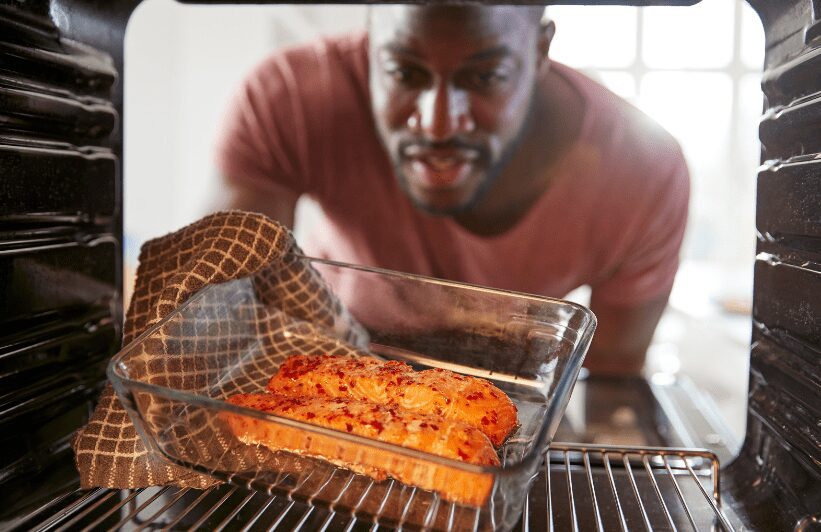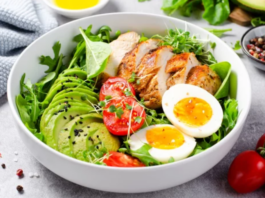Bake salmon in the oven if you want a simple weeknight meal. Stop believing that seafood recipes are exclusively appropriate for upscale dining establishments, and start incorporating them into your weekly menu.
Whether you are hosting a weekend gathering or a small weeknight dinner, high-protein salmon provides numerous health benefits and is easy to bake in the oven.
From prepping this nutrient-rich fish to ensuring the proper cooking temperature, there are several key considerations when creating a perfectly cooked meal. Here are our top tips to bake salmon in gas or electric ranges.
Choose The Proper Cut Of Salmon To Bake
Choosing the best cut is essential when determining how to bake salmon with your favorite recipe.
Wild caught salmon was captured in its natural environment, while farm-raised salmon was harvested in controlled conditions.
Select a piece that is vibrant in color and free from any discolorations to ensure the best flavor.
While salmon steaks are ideal for broiling, grilling, and pan-searing, salmon fillets are the best for baking.
Keep in mind about six ounces of skinless fish is the typical serving size per person (add one more ounce if cooking with skin on).
Here’s a look at the various fillets:
Top loin: Often called the “tenderloin” for its high quality, this cut is also the heartiest.
Belly: With its high-fat content, the melt-in-your-mouth cut provides the most Omega 3s.
Loin: The bright fillet is best known for its equal balance of fat-to-flesh.
Second cut: This is the most popular choice for its moist and tender qualities.
Tail: The tapered tail meat offers the thinnest cut.
Frozen Salmon Vs. Fresh Salmon
While there is nothing quite like fresh salmon, having frozen salmon stocked in your freezer will save you a trip to the market. Choose a cut that has a bright color and looks moist and not dry.
Fresh salmon can stay in your refrigerator for up to two days. If the label says “previously frozen,” it means after the salmon was caught, it was flash-frozen to lock in nutrients and ensure freshness. Frozen salmon can also be thawed before cooking to remove excess moisture.
Prepping Salmon For Baking
Most pin bones have been removed from fillets, making prep more accessible and faster, but checking for missed ones is a good idea.
To do this, place the salmon over an inverted mixing bowl (like one from KitchenAid’s 3 Piece Plastic Mixing Set) skin side down, revealing any small bones protruding from the fleshy side-up portion the fish.
Take a pair of kitchen pliers or tweezers and remove the bones. Whether you choose a roasting pan like our favorite porcelain enamel roaster by Tramontina or a baking dish is up to you, but line with a lightly oiled foil.
Aluminum foil seals in moisture, so the salmon retains its natural juices, and the oil will prevent it from sticking. Salmon should always be prepped for baking by seasoning well with salt and pepper.
Your favorite seafood rub or a dash of FreshJax Seasoned Sea Salts for some extra spice may also be added to enhance flavor.
Should You Bake Salmon With Skin On Or Skin Off
To Bake salmon with the skin on or skin off is your preference. While searing salmon in a cast iron pan like Lodge’s pre-seasoned skillet produces a crisp skin, baked salmon produces moist skin.
If you prefer skinless fillets, removing the skin before or after cooking is easy. When removing before baking, take a sharp knife, insert it into the fish above the skin, and slide along slowly, taking care not to cut the flesh until the skin has been entirely removed.
If you prefer to remove after baking skin side down, take a spatula and glide it between the skin and fleshy part to remove the skin in one piece.
Cooking Time And Temperatures For Baking Salmon
A common mistake when baking salmon in the oven is overcooking. If you don’t keep an eye on the clock, the salmon will become dried out, losing its flavor.
We recommend cooking the salmon on the middle oven rack to ensure it bakes evenly without burning.
A baking dish with skin side up should be placed in the oven once the oven is preheated to 450 degrees.
Salmon usually needs 10 to 15 minutes to bake until the thickest section of the fish reaches a temperature of 145 degrees. The salmon will be fully baked after it gets a pale pink color.
If you prefer an extra juicy fish, the seasoned salmon can also be wrapped in aluminum foil (“en papillote”) and filled with your favorite vegetables.
To create using this method, take a large sheet of aluminum foil, fold in half lengthwise, unfold and place it on your baking dish.
The salmon and vegetables are added to one side of the foil before folding over the other. Seal off the foil bag by crimping the aluminum foil together. The salmon will stay moist if no steam escapes while baking.
After the salmon has been thoroughly cooked, remove it from the oven and allow it to cool for five minutes before serving.
Cut open the foil bag with scissors, removing the flaky salmon and vegetables with a spatula before discarding the foil.
Final Word
That is how you bake salmon in the oven.





